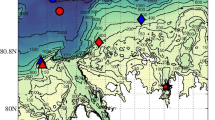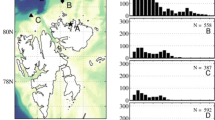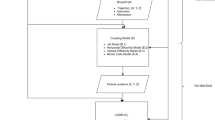Abstract
The approach for modeling bioluminescence (BL) potential is proposed. The approach consists of (1) estimation of the adjoint (by backward in time integration of the adjoint model), (2) generation of ensembles of BL potential initial conditions and source minus sink term, and (3) estimation of two integrals: the integration of the adjoint with the BL potential initial conditions and the integration of the adjoint with the BL potential source minus sink term. In this case, the impact of physical processes on BL potential dynamics is introduced through the one backward integration of the adjoint. The proposed approach has been applied to modeling of the BL potential changes in the area of the submesoscale filament, which developed during the upwelling event in the Monterey Bay area, California. Comparisons of modeled histograms with those observed show that predicted changes in mean BL potential values in the area of filament very closely resemble the observed ones: increase over 5 days in mean BL potential values in the top 15 m and decrease in mean BL potential values between 30 and 45 m depth in the area of the filament. There is a similar good qualitative and quantitative agreement between observed and model-predicted differences in histograms when BL potential values in 30–45 m depth are compared to the BL potential values in the top 15 m.












Similar content being viewed by others

References
Barron CN, Kara AB, Martin PJ, Rhodes RC, Smedstad LF (2006) Formulation, implementation and examination of vertical coordinate choices in the global Navy Coastal Ocean Model (NCOM). Ocean Model 11:347–375. https://doi.org/10.1016/j.ocemod.2005.01.004
Bellingham JG, Streitlien K, Overland J, Rajan S, Stein P, Stannard J, Kirkwood W, Yoerger D (2000) An Arctic basin observational capability using AUVs. Oceanography 13:64–71. https://doi.org/10.5670/oceanog.2000.36
Brankart J, Candille G, Garnier F, Calone C, Melet A, Bouttier P, Brasseur P, Verron J (2015) A generic approach to explicit simulation of uncertainty in the NEMO ocean model. Geosci Model Dev 8:615–643. https://doi.org/10.5194/gmdd-8-615-2015
Campbell JW (1995) The lognormal distribution as a model for bio-optical variability in the sea. J Geophys Res 100:13,237–13,254
Chavez FP, Wright D, Herlien R, Kelley M, Shane F, Strutton PG (2000) A device for protecting moored spectroradiometers from bio-fouling. J Atmos Ocean Technol 17:215–219
Cummings JA (2005) Operational multivariate ocean data assimilation. Quart J Royal Met Soc Part C 131:3583–3604. https://doi.org/10.1256/qj.05.105
Doyle JD, Jiang Q, Chao Y, Farrara J (2009) High-resolution real-time modeling of the marine atmospheric boundary layer in support of the AOSNII field campaign. Deep-Sea Res II 56:87–99. https://doi.org/10.1016/j.dsr2.2008.08.009
Fennel K, Wilkin J, Levin J, Moisan J, O’Reilly J, and Haidvogel D (2006) Nitrogen cycling in the Middle Atlantic Bight: results from a three-dimensional model and implications for the North Atlantic nitrogen budget, Glob Biogeochem Cycles 20(GB3007). doi:https://doi.org/10.1029/2005GB002456
Friedrichs MAM, Dusenberry J, Anderson L, Armstrong R, Chai F, Christian J, Doney SC, Dunne J, Fujii M, Hood R, McGillicuddy D, Moore K, Schartau M, Sptiz YH, Wiggert J (2007) Assessment of skill and portability in regional marine biogeochemical models: role of multiple phytoplankton groups. J Geophys Res 112(CO8001). https://doi.org/10.1029/2006JC003852
Herren CM, Haddock SHD, Johnson C, Orrico CM, Moline MA, Case JF (2005) A multi-platform bathyphotometer for fine-scale, coastal bioluminescence research. Limnol Oceanogr Methods 3:247–262
Lee Z, Du K, Arnone R, Liew S, and Penta B (2005) Penetration of solar radiation in the upper ocean: a numerical model for oceanic and coastal waters,” J Geophys Res 110(C09019). doi:https://doi.org/10.1029/2004JC002780
Marcinko CLJ, Martin AP, Allen JT (2014) Modelling dinoflagellates as an approach to the seasonal forecasting of bioluminescence in the North Atlantic. J Mar Syst 139:261–276. https://doi.org/10.1016/j.jmarsys.2014.06.014
Moline MA, Blackwell SM, Allen B, Austin T, Forrester N, Goldsborogh R, Purcell M, Stokey R, von Alt C (2005) Remote Environmental Monitoring UnitS: an autonomous vehicle for characterizing coastal environments. J Atmos Ocean Technol 22:1798–1809
Moline MA, Blackwell SM, Case JF, Haddock SHD, Herren CM, Orrico CM, Terrill E (2009) Bioluminescence to reveal structure and interaction of coastal planktonic communities. Deep Sea Res II 56(3–5):232–245
Morel A, Huot Y, Gentili B, Werdell PJ, Hooker SB, Franz BA (2007) Examining the consistency of products derived from various ocean color sensors in open ocean (case 1) waters in the perspective of a multi-sensor approach. Remote Sens Environ 111:69–88
Rhodes RC, Hurlburt HE, Wallcraft AJ, Barron CN, Martin PJ, Smedstad OM, Cross S, Metzger JE, Shriver J, Kara A, Ko DS (2002) Navy real-time global modeling systems. Oceanography 15(1):29–43
Ryan JP, Fischer AM, Kudela RM, Gower JFR, King SA, Marin R III, Chavez FP (2009) Influences of upwelling and downwelling winds on red tide bloom dynamics in Monterey Bay, California. Cont Shelf Res 29:785–795. https://doi.org/10.1016/j.csr.2008.11.006
Shulman I, McGillicuddy DJ Jr, Moline MA, Haddock SHD, Kindle JC, Nechaev D, Phelps MW (2005) Bioluminescence intensity modeling and sampling strategy optimization. J Atmos Ocean Technol 22:1267–1281
Shulman I, Rowley C, Anderson S, DeRada S, Kindle J, Martin P, Doyle J, Ramp S, Chavez F, Fratantoni D, Davis R, Cummings J (2009) Impact of glider data assimilation on the Monterey Bay model. Deep Sea Res II 56(3–5):128–138
Shulman I, Moline MA, Penta B, Anderson S, Oliver M, and Haddock SHD (2011) Observed and modeled bio-optical, bioluminescent, and physical properties during a coastal upwelling event in Monterey Bay, California, J Geophys Res 116(C01018). doi:https://doi.org/10.1029/2010JC006525
Shulman I, Penta B, Richman J, Jacobs G, Anderson S, Sakalaukus P (2015) Impact of submesoscale processes on dynamics of phytoplankton filaments. J Geophys Res 120:2050–2062. https://doi.org/10.1002/2014JC010326
Tian RC (2006) Toward standard parameterizations in marine biological modeling. Ecol Model 193:363–386
Waterhouse TY, Welschmeyer NA (1995) Taxon specific analysis of microzooplankton grazing rates and phytoplankton growth rates. Limnol Oceanogr 40:827–834. https://doi.org/10.4319/lo.1995.40.4.082
Acknowledgments
We thank anonymous reviewers for providing very insightful comments and recommendations to improve the paper. Computer time for the numerical simulations was provided through a grant from the Department of Defense High Performance Computing Initiative. This manuscript is US NRL contribution 7330-18-4056.
Funding
This research was funded through the US Naval Research Laboratory under program element 61153N.
Author information
Authors and Affiliations
Corresponding author
Additional information
Responsible Editor: Alejandro Orfila
Appendix
Appendix
Consider the following variable λ satisfying the adjoint to (1) equation:
With initial conditions at t = T
Boundary Sd includes all boundaries of D: lateral boundaries, surface, and bottom.
We multiply (1) by λ and subtract (13) multiplied by C and integrate over domain D and time [t0, T]:
Using (15) and non-divergent condition for velocity, the first term on the right site of (16) is equal to zero:
Because
and boundary conditions (15), the second term on the right site of (16) is also equal to zero:
For the left site of (16), we have:
Combining (17)–(20) together, we have:
In accord to (21), (14), and (3), we have:
Rights and permissions
About this article
Cite this article
Shulman, I., Anderson, S. Bioluminescence potential modeling with an ensemble approach. Ocean Dynamics 69, 599–614 (2019). https://doi.org/10.1007/s10236-019-01264-4
Received:
Accepted:
Published:
Issue Date:
DOI: https://doi.org/10.1007/s10236-019-01264-4



